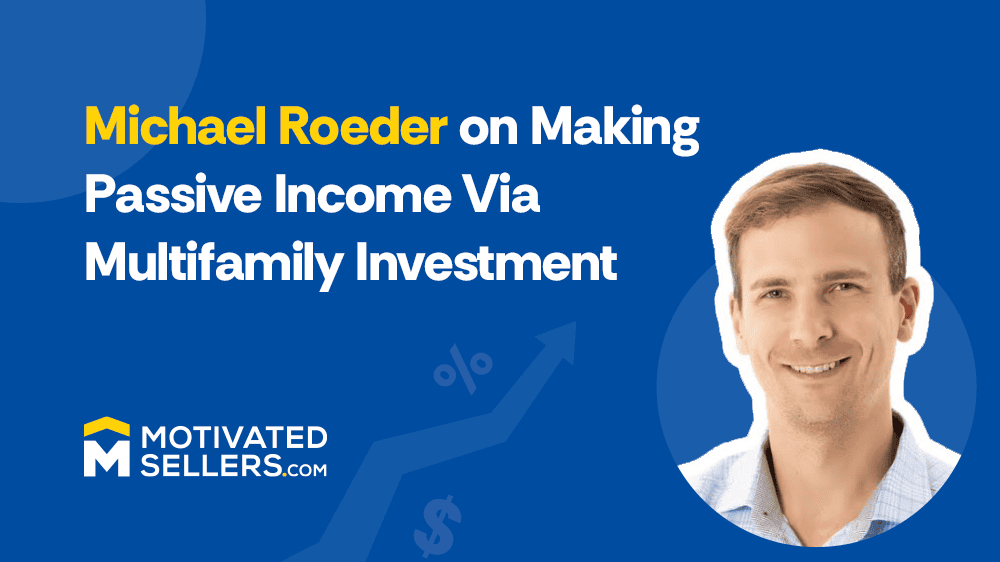

This conversation happened with Michael Roeder—co-owner of Granite Towers Equity Group, which manages over $300 million in assets and has a strong reputation for delivering high returns for investors.
Michael was working as a high-net-worth agent for a Fortune 500 company before starting out as an investor. He was helping clients save millions in assets. His experience as an insurance agent gave him the ability to manage risk and make safe decisions for the Granite Towers Equity Group portfolio.
Michael is the co-host of Keeping It Real real estate podcast and the co-author of 4 Steps to Successful Passive Investing.
I was just 20 when the real estate bug bit me. Together with my girlfriend (now my wife of 16 years), we decided that we’d buy a 4-bedroom house located next to the campus. It was a 1924 construction. We lived in one bedroom and rented out the other three—which turned out to be our first attempt at house hacking. It was an enjoyable experience, as we lived in the house for free and earned cash flow. After a while, we turned that property into a full-blown rental.
We accumulated a handful of single-family properties using multiple means, i.e., 401(k) loans, home equity, and personal loans. We were just getting started in the investment world back in 2008–2009, and my goal was to own 100 rental properties. At that time, I had no idea about passive income.
My portfolio was expanding, but I was managing everything, including maintenance and evictions. I started experiencing burnout because I was commuting over an hour for my day job in Minneapolis. So I was traveling all day just to manage my day job and rental properties.
My then-business partner (also a professional snowboarder) was advised to offset his income by investing in apartment complexes. Together, we pooled our funds and started investing in apartment complexes to scale our real estate portfolio back in 2014.
Michael and his partners have 70% of their investments in Dallas and Fort Worth. They own 3,000+ units in Nashville, which is a robust, growing market. They also have a few investments in Minnesota.
When it comes to choosing a market, Michael suggests selecting a landlord- and business-friendly state. Consider Dallas, which has no state income tax, tons of Fortune 500 companies, and landlord-friendly legislation.
We entered Nashville because a business partner already had connections there. He had the necessary relationships and business setup, which helped us.
We did deals in New Mexico, Wisconsin, and Alabama. Here’s the thing about investing in multiple markets:
When you invest everywhere, you end up creating more problems because you need to keep a pulse on these markets, arrange site visits, and manage multiple vendors and property managers.
We offer an 80/20 split, with 80% of the cash flow and equity going to our investing partners. After hitting a certain return metric (typically 16%–18%), the structure shifts to a 70/30 split. If a deal is refinanced, all limited partners retain their original equity position—which is a significant advantage.
My first multifamily investment was a value-add project, just under 100 units in Dallas. We held the project for three years with a successful increase in NOI. They had an office in a 2-bedroom townhouse which we moved to a maintenance section. The townhouse rented for $2,000/month.
We added a laundry centre and renovated almost 100% of the units. Our original projection was a 14% annualized return (70% over 5 years), but we ended up achieving a 103% annualized return over 3 years. That means our partner investors tripled their money over a three-year period.
We are at the bottom of the multifamily real estate cycle with high interest rates. A lot of institutional and retail capital has paused their investment. In the last three or four years, prices have dropped by 20%–30% in the multifamily space.
The situation is slowly stabilizing. It’s possible that interest rates will go down in the near term. A lot of capital is moving into the multifamily space, which will compress cap rates. As a result, property values will go up. As investors, we are excited about the state of the market, but it’s important to invest in the right property and adjust your acquisition criteria as necessary.
Before you can invest retirement funds, you must transfer funds to a different intermediary that handles self-directed investment. If you have a typical IRA through Fidelity or Goldman (or other providers), then you might not be allowed to invest in alternative investments. You just need to transfer money to a self-directed IRA so you can invest in real estate, cryptocurrency, or other channels of your choice.
Get to know the individuals who are putting together the project. Make sure they have the time, bandwidth, and knowledge to create a successful investment project. Lots of syndicators are putting together projects while working a full-time job. That means they won’t have the level of expertise or bandwidth required to manage multifamily investments.
Understand the market. Which city are you investing in?
Ask questions, understand numbers, and get somebody else to review the underwriting of the deal. Even the slightest adjustments to rent growth, vacancy rate, reversion cap rate, or rental rates can make a big difference in the returns. Underwriting should always be conservative, and you must have an in-depth understanding of all the numbers.
Avoid tenant-friendly states. We know investors facing difficulties in New York because evictions take years there. Before investing in a market, review:
For example, we invested in a property in Carlsbad, New Mexico. COVID came, oil went negative, and Carlsbad was an oil market. We saw a massive exodus of jobs in that region, and it significantly affected our occupancy and rental rates. We learned a key lesson:
Find a really good mentor and partner with someone who is already a successful multifamily investor. Collaborate first, even if that means, working for free because the lessons learned will be invaluable.
We lost a lot of cash on the first few apartment complexes because we didn’t know exactly what we were doing. We could have passively invested those funds with a good operator and learned along the way. Or we could have partnered with someone who had more experience and gave them some equity. In either way, we would have done much better.
I partnered with two other investors, with each of us bringing about $160k. For me, it was some cash and a home equity loan. Then we got about 75% leverage from Fannie Mae, which is an agency loan.
At Granite Towers Equity Group, we typically acquire 100–400 units. In that space, there are numerous sophisticated buyers and brokers. We find off-market deals through sales brokers.
One of our first investments was a 20-unit apartment complex. We invested in our hometown (Minnesota, a small tertiary market). There was a college close to the city, and because of some immigration issues, enrollment ended up plummeting. All the student properties around that campus started converting into family housing.
We didn’t realize such a thing could happen. Our occupancy rate went down along with rental rates. We didn’t make any money from that property despite holding it for four years. We broke even because a lot of sweat equity was invested. The failure gave us an important lesson: understand all aspects of an investment market before jumping in.
My wife Brianna and I have two daughters, 9 and 13. We are just getting them involved in the business and entrepreneurship. It has been a lot of fun. We bring them on property site visits, due diligence, and networking events, which is phenomenal.
On the business side, we’re looking to go from about 3,000 units to 12,000 units over the next decade. We will continue building our team, investing in multifamily, and we are growing a 3N lease investment arm of our company, which we recently started.